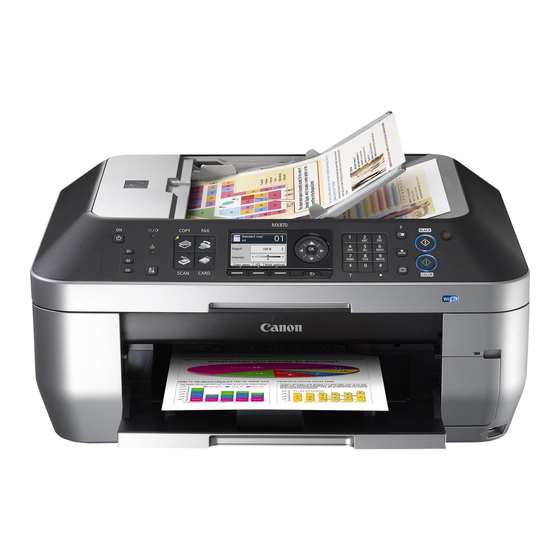
Canon PIXMA MX870 Network Setup Manual
Network setup troubleshooting
Hide thumbs
Also See for PIXMA MX870:
- User manual (1128 pages) ,
- Getting started (91 pages) ,
- Service manual (67 pages)
Table of Contents
Advertisement
Advertisement
Table of Contents

Summary of Contents for Canon PIXMA MX870
- Page 1 Network Setup Troubleshooting...
-
Page 2: Table Of Contents
This manual mainly describes problems you may encounter when setting up a network, and the possible causes and solutions. Find a description related to your problem and follow the solution. If you cannot find a description for your problem or if you encounter a problem after setup, refer to the on- screen manual: Basic Guide/Advanced Guide. -
Page 3: Problems During Network Setup
Problems during Network Setup Easy setup Advanced setup The Target Access Point is Not Displayed (Detected) Check Check 1 Make sure that you follow Check 1, 2, 5 and 6 of "Connection Checklist" on page 12, then press the left FUNCTION button (A) on the machine to search for the access point again. -
Page 4: Access Point Was Not Detected. Is Displayed
Access point was not detected. is Displayed Check The message appears when no access point is found. Refer to "The Target Access Point is Not Displayed (Detected)" on page 1. Failed to connect to the access point. is Displayed Check Check 1 Is WEP key number 2, 3 or 4 of the access point in use? •... -
Page 5: Multiple Access Points With The Same Name Exist. Is Displayed
Multiple access points with the same name exist. is Displayed Check The message appears when multiple access points with the same name are found. When you have only one access point Select Use one AccessPoint only, then select the MAC address of the target access point. -
Page 6: The Device May Not Be Able To Connect To The Network Is Displayed
Check 5 Is "WPA/WPA2 Enterprise" set as a security protocol (encryption standard) on the access point? "WPA/WPA2 Enterprise" is not supported on the machine. Change the security protocol (encryption standard) for the access point, then configure settings again. • After that, press the OK button, then proceed with the setup from Point's Wireless LAN Settings Directly on the Machine"... -
Page 7: Wps
Cannot connect. Multiple access points are enabled. is Displayed Action The message appears when multiple access points are detected. Wait for a while, then configure the settings again. Connection failed. is Displayed Check The message appears when an error occurs. Check the access point settings, then configure WPS settings again. -
Page 8: Check Printer Settings Dialog Box Is Displayed
Check 4 When obtaining an IP address automatically, make sure that the DHCP function of the network device (router, access point, etc.) is active. • For details on how to check settings of the network device, refer to the manual supplied with the network device or contact its manufacturer. -
Page 9: Other Troubleshooting Tips
Check 4 When obtaining an IP address automatically, make sure that the DHCP function of the network device (router, access point, etc.) is active. • For details on how to check settings of the network device, refer to the manual supplied with the network device or contact its manufacturer. -
Page 10: Reference Information
Reference Information Character Entry Action This machine allows you to enter characters using the Numeric buttons (A). Follow the procedure below. Press the button of the Numeric buttons to switch to the character entry mode you want to use. • Three character entry modes (numeric, upper case and lower case) are available. -
Page 11: Entering The Access Point's Wireless Lan Settings Directly On The Machine
Entering the Access Point's Wireless LAN Settings Directly on the Machine Action Enter the access point name/network name (SSID) and security setting (WEP, WPA, etc.) on the machine directly. Follow the procedure below. Press the Setup button. Use the [ or ] button to select Wireless LAN Setup, then press the OK button. - Page 12 10-A Select the WEP key number you want to use, then press the OK button. • When using AirPort, select WEP key 1 in the screen. Selecting other key numbers will disable the connection between the machine and AirPort. Enter the network key, then press the OK button.
-
Page 13: Specifying The Machine's Ip Address (Ipv4 Only)
Specifying the Machine's IP Address (IPv4 only) Action The machine's IP Address can be specified by the following procedure. Press the Setup button. Select Device settings, then press the OK button. Select LAN settings, then press the OK button. Select Other settings, then press the OK button. Select IPv4/IPv6 setting, then press the OK button. -
Page 14: Connection Checklist
Is the firewall function of your security software active? A message may appear on the computer monitor warning that Canon software is attempting to access the network. If the warning message appears, set the security software to always allow access. - Page 15 Check 6 Is the access point operating in IEEE802.11b or IEEE802.11g (2.4 GHz)? • For details on how to check the operating mode of the access point, refer to the manual supplied with the access point or contact its manufacturer. Set the access point to operate in IEEE802.11b or IEEE802.11g (2.4 GHz).
- Page 16 QT5-2855-V01 XXXXXXXX ©CANON INC.2010 PRINTED IN XXXXXXXX...















